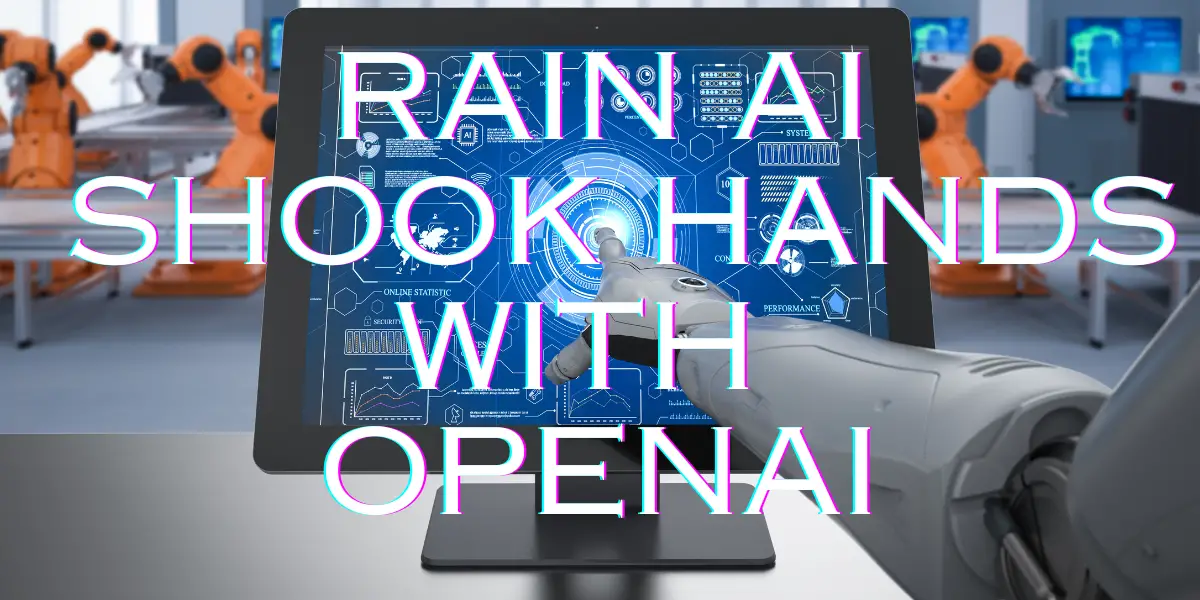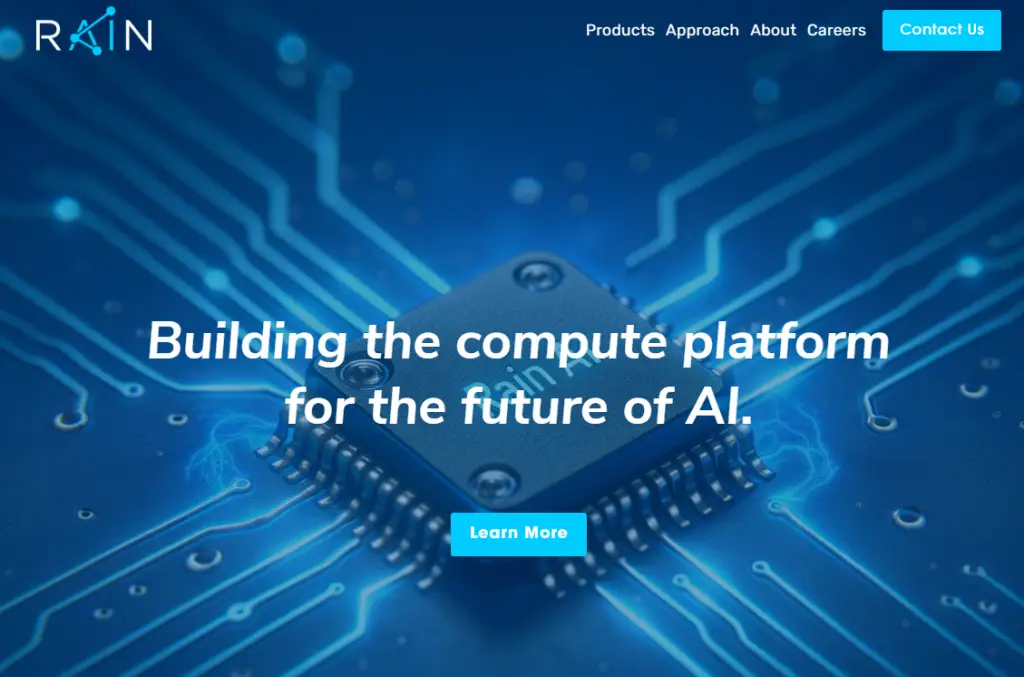Rain AI Shook Hands with OpenAI: Embarking on a New Era of AI Innovation

In an era where AI tools are reshaping every facet of our lives, a groundbreaking development unfolds as Rain AI shook hands with OpenAI, marking a pivotal moment in the realm of artificial intelligence. This collaboration brings together Rain AI’s innovative neuromorphic processors and OpenAI’s extensive expertise in AI research, setting the stage for a new wave of technological advancements. This alliance promises to leverage the strengths of both entities to push the boundaries of what AI tools can achieve, heralding a future where AI is more accessible, sustainable, and aligned with human values.
The collaboration between Rain AI and OpenAI marks a significant leap in AI development, combining Rain AI’s advanced neuromorphic processors with OpenAI’s cutting-edge research. This partnership is set to enhance AI’s efficiency, accessibility, and ethical alignment, potentially revolutionizing AI applications in various sectors and setting new standards for responsible AI development.
Table of Contents
Rain AI shook hands with OpenAI
In a landmark event for the AI industry, Rain AI, an emerging force in neuromorphic processor technology, officially joined hands with OpenAI, a leading non-profit AI research company. This significant partnership was formalized in 2019, marking a pivotal moment in the advancement of AI technologies.
At the core of this collaboration lies a shared vision for the future of artificial intelligence. Rain AI, with its innovative approach to developing neuromorphic processors (NPUs), brings a fresh perspective to the AI hardware landscape. These NPUs, known as “Digital Dendrites,” are inspired by the human brain’s structure and function, offering a new paradigm in processing efficiency and power consumption. The design and capabilities of these NPUs represent a leap forward in mimicking the brain’s natural efficiency in information processing, a key aspect that traditional computing systems have long struggled to emulate.
OpenAI’s commitment in this partnership is substantial, with an agreement to purchase $51 million worth of Rain AI’s NPUs upon their commercial availability. This investment is not just a financial endorsement but also a testament to OpenAI’s belief in the transformative potential of Rain AI’s technology. It underscores a mutual understanding of the critical role specialized hardware plays in the evolution of AI applications, especially in an era where personalized and energy-efficient AI solutions are becoming increasingly important.
The partnership between Rain AI and OpenAI is more than a business transaction; it’s a fusion of complementary strengths. While Rain AI brings cutting-edge hardware innovations, OpenAI contributes its extensive research and expertise in AI software and applications. This synergy is expected to catalyze significant advancements in AI, paving the way for more sophisticated, efficient, and accessible AI technologies.
As we stand on the brink of 2024, this collaboration between Rain AI and OpenAI is not just a significant milestone for the companies involved but a beacon of progress for the entire AI industry. It represents a forward leap in the quest to harness the true potential of artificial intelligence, promising to unlock new capabilities and applications that were once considered the realm of science fiction.
What is Rain AI?
Rain AI emerged as a visionary startup in the realm of artificial intelligence, with a specific focus on revolutionizing AI hardware. Founded with the ambition to bridge the gap between the burgeoning demands of AI applications and the limitations of current hardware technologies, Rain AI has positioned itself at the forefront of neuromorphic processor development. The company’s vision extends beyond mere technological advancement; it aims to redefine how AI systems are powered, making them more efficient, adaptable, and closer to the functioning of the human brain. This vision is rooted in the belief that the future of AI lies in hardware that can not only keep pace with software advancements but also drive them forward.
Central to Rain AI’s innovation is the development of their neuromorphic processors, aptly named “Digital Dendrites.” These processors are a radical departure from traditional silicon-based chips, drawing inspiration from the neural architecture of the human brain. Unlike conventional CPUs and GPUs that process tasks sequentially, Rain AI’s NPUs are designed to process information in a parallel, distributed manner, mimicking the brain’s natural efficiency. This design allows for significant improvements in processing speed and energy efficiency, addressing two of the most pressing challenges in modern AI: the need for speed and the growing energy footprint of AI systems. The potential of these NPUs is vast, with claims of being up to 100 times more powerful and 10,000 times more energy-efficient than traditional GPUs.
Despite its innovative technology and ambitious vision, Rain AI navigates a competitive and rapidly evolving AI landscape. The company’s journey from a startup to a key player in the AI hardware market is marked by both opportunities and challenges. On one hand, Rain AI’s technology has garnered interest and investment from major industry players, including a significant commitment from OpenAI. This support underscores the industry’s recognition of the potential impact of Rain AI’s NPUs. On the other hand, Rain AI faces the daunting task of competing against established giants like Nvidia, Google, and Amazon, who dominate the AI hardware space. The success of Rain AI hinges not just on the technical prowess of its NPUs but also on its ability to navigate market dynamics, forge strategic partnerships, and continually innovate in response to the ever-changing needs of AI applications.

What is OpenAI?
OpenAI, established as a non-profit research organization, has rapidly evolved into a prominent name in the field of artificial intelligence. Founded with the mission to ensure that artificial general intelligence (AGI) benefits all of humanity, OpenAI stands as a beacon of ethical and responsible AI development. The organization was born out of a collective realization by industry luminaries that advancements in AI should be aligned with human values and controlled to avoid potential risks. OpenAI’s commitment to openly sharing its research and findings reflects its dedication to collaborative progress in the AI field. This ethos not only drives innovation but also fosters a culture of transparency and ethical responsibility, setting a standard in the AI community.
OpenAI’s journey is marked by significant research endeavors and groundbreaking achievements in AI. The organization has been at the forefront of developing advanced AI models, including notable projects like GPT (Generative Pretrained Transformer) series and DALL-E, which have pushed the boundaries of natural language processing and generative AI. These models demonstrate OpenAI’s expertise in creating AI that can understand, interpret, and generate human-like text, offering possibilities that range from writing assistance to creative content generation. Furthermore, OpenAI’s research extends into the realms of robotics and reinforcement learning, showcasing its versatility and commitment to exploring diverse AI applications. The impact of these innovations is profound, influencing a wide array of sectors from healthcare to education, and redefining the interaction between humans and machines.
OpenAI’s influence extends beyond its technical achievements. The organization plays a pivotal role in shaping the global AI landscape, advocating for policies and practices that promote safe and beneficial AI. Through partnerships, collaborations, and open dialogues with policymakers, industry leaders, and the broader community, OpenAI actively contributes to the development of ethical AI frameworks and standards. This leadership role is crucial in an era where AI’s societal impact is increasingly scrutinized. OpenAI’s commitment to balancing innovation with responsibility not only guides its own research but also inspires other entities in the AI ecosystem to prioritize ethical considerations in AI development. As AI becomes more integrated into everyday life, OpenAI’s approach serves as a guiding light for responsible and human-centric AI advancement.

How do NPUs work?
The Basic Architecture of NPUs
Neuromorphic Processing Units (NPUs) represent a paradigm shift in processor design, inspired by the neural structure of the human brain. Unlike traditional CPUs and GPUs that process data through a linear and sequential approach, NPUs utilize a network of artificial neurons and synapses. This network is designed to mimic the brain’s ability to process information in parallel, allowing for simultaneous data processing. Each artificial neuron in an NPU can independently process information, leading to a significant boost in computational speed and efficiency. This architecture enables NPUs to handle complex AI tasks, such as pattern recognition and decision-making, more efficiently than traditional processors. The parallel processing capability of NPUs is particularly advantageous for machine learning and deep learning applications, where handling vast amounts of data simultaneously is crucial.
Energy Efficiency and Speed
One of the most significant advantages of NPUs is their energy efficiency. Traditional processors, while powerful, consume a lot of energy and generate substantial heat, especially when processing complex AI algorithms. NPUs, on the other hand, are designed to be much more energy-efficient. They achieve this by mimicking the brain’s ability to perform complex computations with minimal energy. This efficiency is crucial for deploying AI in real-world applications where power availability is limited, such as in mobile devices or remote sensors. Additionally, the speed of NPUs in processing AI tasks is remarkable. Thanks to their parallel processing architecture, NPUs can handle multiple operations simultaneously, drastically reducing the time required for data processing and analysis. This speed is essential for applications requiring real-time decision-making, such as autonomous vehicles or advanced robotics.
Learning and Adaptation Capabilities
A defining feature of NPUs is their ability to learn and adapt. This is achieved through a process that emulates synaptic plasticity found in the human brain. In NPUs, the strength of the connections between artificial neurons can be adjusted based on the input data, allowing the system to learn from new information and experiences. This capability is particularly important for machine learning applications, where the processor must adapt and improve over time. NPUs can dynamically adjust their processing strategies, making them more flexible and capable of handling a variety of AI tasks. This learning ability also means that NPUs can become more efficient and accurate in their computations as they process more data, a key advantage in evolving AI environments where adaptability is crucial.
How can Rain chips help with the development of AI?
Accelerating AI Model Training and Inference
Rain chips, with their advanced neuromorphic design, are poised to revolutionize the way AI models are trained and inferred. Traditional GPUs, while effective, face limitations in handling the increasingly complex and data-intensive demands of modern AI algorithms. Rain chips, however, are engineered to process these complex algorithms more efficiently. Their ability to perform parallel processing, mimicking the human brain’s neural network, allows for faster and more efficient training of AI models. This efficiency is crucial in reducing the time and computational resources required for training, enabling more rapid development and deployment of AI solutions. Additionally, the enhanced processing capabilities of Rain chips mean that AI models can infer and make decisions more quickly, a critical requirement for applications like autonomous vehicles and real-time data analysis.
Enabling More Complex and Sophisticated AI Applications
The advanced capabilities of Rain chips open the door to more complex and sophisticated AI applications that were previously unfeasible due to hardware limitations. Their neuromorphic architecture allows for handling intricate patterns and nuances in data, which is essential for applications such as natural language processing, image recognition, and predictive analytics. With Rain chips, AI systems can achieve a higher level of accuracy and detail, allowing for more nuanced and sophisticated responses. This advancement is particularly significant in fields such as healthcare for diagnostic tools, financial services for fraud detection, and in the development of more interactive and responsive AI assistants. The ability to process and analyze complex data sets efficiently means that AI can be applied to more challenging problems, pushing the boundaries of what’s possible in AI research and application.
Reducing Energy Consumption and Environmental Impact
One of the critical challenges in the development of AI is the high energy consumption associated with training and running AI models. Rain chips address this issue head-on with their energy-efficient design. By mimicking the energy efficiency of the human brain, Rain chips consume significantly less power compared to traditional AI processing hardware. This reduction in energy consumption is not only cost-effective but also crucial for reducing the environmental impact of large-scale AI operations. As AI becomes more integrated into various sectors, the sustainability of AI systems is increasingly important. Rain chips offer a solution that balances performance with environmental responsibility, enabling the growth of AI technology in a more sustainable and eco-friendly manner.
Altman returns
The AI industry witnessed a notable moment with the return of Sam Altman to OpenAI. Altman, a prominent figure in the tech world, co-founded OpenAI and initially served as its CEO before stepping away to pursue other ventures. His return marks a significant milestone, not just for OpenAI but for the broader AI community. Altman’s comeback is seen as a reaffirmation of his commitment to OpenAI’s mission of ensuring that artificial general intelligence (AGI) benefits all of humanity. Known for his visionary leadership and deep understanding of both the technological and ethical dimensions of AI, Altman’s presence is expected to further invigorate OpenAI’s endeavors. His return coincides with a period of rapid advancement and heightened public interest in AI, symbolizing a renewed focus on steering AI development towards beneficial and responsible outcomes. Altman’s leadership is particularly crucial as OpenAI navigates new challenges and opportunities in its quest to shape the future of AI in a way that aligns with human values and societal needs.
Also read: Open Letter Seals Unity: OpenAI Employees Call for Leadership Overhaul

The Future of AI with Rain AI and OpenAI
Pioneering New Frontiers in AI Technology
The collaboration between Rain AI and OpenAI is set to pioneer new frontiers in AI technology. This partnership combines Rain AI’s groundbreaking neuromorphic processors with OpenAI’s cutting-edge AI research, creating a synergy that could lead to significant advancements in AI capabilities. The integration of Rain AI’s hardware, known for its efficiency and brain-like processing, with OpenAI’s sophisticated AI models, promises to enhance the speed, efficiency, and complexity of AI systems. This collaboration is poised to tackle some of the most challenging problems in AI, such as creating more advanced natural language processing systems, improving machine learning algorithms, and developing AI that can understand and interact with the world in more human-like ways. The future of AI with Rain AI and OpenAI looks towards not only advancing the technical aspects of AI but also ensuring these advancements are aligned with ethical and responsible AI development.
Catalyzing a Shift in AI Accessibility and Sustainability
The partnership between Rain AI and OpenAI is expected to catalyze a significant shift in AI accessibility and sustainability. By combining Rain AI’s energy-efficient chips with OpenAI’s AI models, this collaboration aims to make powerful AI tools more accessible to a broader range of users, including smaller enterprises and individuals who may not have the resources for high-end AI computing. This democratization of AI technology has the potential to spur innovation across various sectors, enabling new startups and researchers to contribute to the AI field. Furthermore, the focus on energy efficiency is a step towards more sustainable AI development, addressing one of the major concerns in the field regarding the environmental impact of large-scale AI computations. This shift towards more accessible and sustainable AI could lead to more inclusive and responsible growth in the AI industry, ensuring that the benefits of AI advancements are shared widely and ethically.
Impact on the AI Ecosystem
Revolutionizing AI Hardware and Software Integration
The collaboration between Rain AI and OpenAI is set to revolutionize the integration of AI hardware and software, creating a significant impact on the AI ecosystem. Rain AI’s neuromorphic processors offer a new level of hardware efficiency and capability, which, when combined with OpenAI’s sophisticated AI algorithms, can lead to more seamless and powerful AI systems. This integration is crucial for developing AI that is not only more advanced but also more practical for real-world applications. It could lead to breakthroughs in areas like autonomous systems, where the synergy of efficient hardware and advanced software is key. Additionally, this integration is expected to drive innovation in AI software development, as developers will have access to more capable hardware platforms, encouraging them to create more complex and intelligent AI solutions. This could accelerate the evolution of AI technologies, pushing the boundaries of what’s currently possible.
Setting New Standards in Ethical AI Development
The partnership between Rain AI and OpenAI is also poised to set new standards in ethical AI development, influencing the AI ecosystem profoundly. Both organizations have shown a commitment to responsible AI development, and their collaboration could establish new benchmarks for ethical considerations in AI. This includes the development of AI that is transparent, fair, and respects user privacy and security. By setting these standards, Rain AI and OpenAI could influence other companies and developers in the AI field to adopt similar practices, leading to a more ethical and responsible AI landscape. Furthermore, their focus on creating AI that is beneficial for all of humanity could inspire more research and development in AI applications that address social and global challenges, such as healthcare, education, and environmental sustainability. This shift towards ethical AI development is crucial for ensuring that the advancements in AI technology are aligned with societal values and contribute positively to humanity.
Conclusion
As we reflect on the groundbreaking collaboration between Rain AI and OpenAI, it’s clear that this alliance is not just a milestone in AI development but a harbinger of a transformative era in technology. The fusion of Rain AI’s innovative neuromorphic processors with OpenAI’s trailblazing AI research promises to accelerate the evolution of AI, making it more efficient, accessible, and aligned with ethical standards. This partnership is poised to redefine the boundaries of AI capabilities, fostering advancements that could reshape our interaction with technology and its role in society. The future of AI, shaped by the synergy of Rain AI and OpenAI, looks brighter, more inclusive, and responsible, heralding a new age of technological innovation that prioritizes human values and sustainability.

